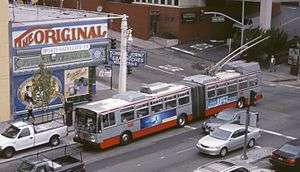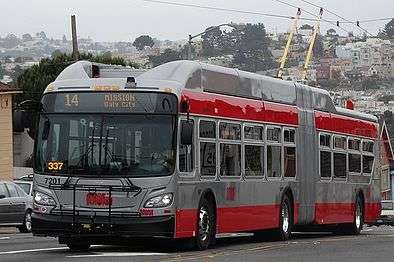Trolleybuses in San Francisco
.jpg) | |
| Operation | |
|---|---|
| Locale | San Francisco, California, United States |
| Open | 1935 |
| Status | Open |
| Operator(s) |
Market Street Railway (1935–1944) San Francisco Municipal Railway (1941–present) |
| Infrastructure | |
| Electrification | 600 V DC |
| Stock | approx. 300 |
| Website | San Francisco Municipal Railway |
The San Francisco trolleybus system forms part of the public transportation network serving San Francisco, in the state of California, United States. Opened on October 6, 1935,[1] it presently comprises 14 lines, and is operated by the San Francisco Municipal Railway, commonly known as Muni (or the Muni), with around 300 trolleybuses – or trolley buses (two words), the common American English spelling of the term. In San Francisco, these vehicles are also known as "trolley coaches" (a term that was the most common name for the mode in the United States in the middle decades of the 20th Century).
One of only five such systems currently operating in the U.S.,[2] the Muni trolley bus system is the second-largest such system in the Western Hemisphere, after that of Mexico City. A particularly notable feature of its operations are very steep grades. The system includes the single steepest known grade on any existing trolley bus line in the world,[3][4][5][6] specifically 22.8% in the block of Noe Street between Cesar Chavez Street and 26th Street on route 24-Divisadero,[3][5][7] and several other sections of Muni trolley bus routes are among the world's steepest.[8]
The Muni trolley bus system is complementary to the city's rail-bound Caltrain, Bay Area Rapid Transit, Muni Metro and cable car system. In addition, it shares some of its overhead wires with the F Market & Wharves streetcar line.
Lines

Trolley buses currently operate the following Muni routes:[9]
| 1 California | Drumm Street – California Street – 33rd Avenue/Geary |
| 2 Clement (Short turn) | Ferry Plaza – Sutter Street – Presidio Avenue |
| 3 Jackson | Sutter Street – Jackson Street – Presidio Avenue |
| 5 Fulton/5R Fulton Rapid | Transbay Terminal – Fulton Street – La Playa/Ocean Beach |
| 6 Haight-Parnassus | Ferry Plaza – Parnassus Street – Quintara Street |
| 14 Mission | Ferry Plaza – Mission Street – San Jose Avenue/Daly City |
| 21 Hayes | Ferry Plaza – Hayes Street – Stanyan/Fulton |
| 22 Fillmore | 3rd St./20th – Fillmore Street – Marina Boulevard |
| 24 Divisadero | Jackson Street – Divisadero Street – Oakdale/Palou/3rd Street |
| 30 Stockton | Caltrain Depot – Stockton Street – Jefferson/Beach |
| 31 Balboa | Ferry Plaza – Balboa Street – La Playa/Ocean Beach |
| 33 Ashbury-18th Street | Maple Street – Stanyan Street – Potrero/25th Street |
| 41 Union | Main Street – Union Street – Lyon/Greenwich |
| 45 Union-Stockton | Lyon Street – Union Street – Stockton Street – Caltrain Depot |
| 49 Van Ness-Mission | North Point Street – Van Ness Avenue – Mission Street – City College |
Line 41 operates only in rush hour. The San Jose Avenue terminal of line 14 is in the neighboring municipality of Daly City.
Fleet
Fleet (2010–present)


As of January 2010, the exclusively high-floor Muni trolley bus fleet included 313 serviceable vehicles, comprising three different types, of which 240 were conventional length (two-axle) buses and 73 articulated buses.[9][10] Of the latter, 40 were New Flyer E60 vehicles (built in 1993–94); 12 of these were retired in early 2013,[11] and the remaining 28 were retired in early January 2015.[12] All of the then-remaining 273 trolleybuses were built by Electric Transit, Inc. (ETI), mostly in 2001–03, the 240 40-foot units being model 14TrSF and the 33 articulated units being model 15TrSF.
An order was placed in 2014 for 60 New Flyer XT60 articulated vehicles, the system's first low-floor trolleybuses. Two prototypes (Nos. 7201 and 7202) arrived in March 2015 and May 2015, respectively,[13] and entered service in May[13] and September 2015.[14] Delivery of the 58 production-series vehicles began in September 2015, and the series entered service between November 2015[14] and July 2016. They replaced the 33 ETI 15TrSF articulated trolleybuses, the last of which were retired in April–May 2016. These changes left the current fleet with the 240 conventional units built by ETI (model 14TrSF) and 60 New Flyer XT60s. The articulated trolleybuses are used on the 14 and 30S lines.
| Fleet numbers | Quantity | Manufacturer | Propulsion | Model | Configuration | Year built |
|---|---|---|---|---|---|---|
| 5401–5640 | 240 | Electric Transit, Inc. (ETI) (Škoda/AAI Corp.) | Škoda Electric | 14TrSF | Conventional | 1999 (first two), 2001–2003 |
| 7201–7260 | 60 | New Flyer | Vossloh Kiepe | XT60 | Articulated, low-floor | 2015–2016 |
The suffix SF in the two ETI model numbers stands for San Francisco. These two types were specially derived from the standard series Škoda 14Tr for use on the Muni system. The model XT60 for New Flyer has prefixes X for Xcelsior and T for electric (trolleybus), and the suffix 60 for the 60-foot bus.
Future fleet
In 2013, the SFMTA adopted plans for an eventual one-for-one replacement of the existing trolleybus fleet in a joint agreement with King County Metro and New Flyer over technical specifications and pricing.[15] The first order to be placed under the 2013 agreement was the 2014 order for 60 articulated trolleybuses, delivery of which began in 2015.[13]
| Fleet numbers | Proposed quantity | Manufacturer | Propulsion | Model | Configuration | Year built (projected) | Notes |
|---|---|---|---|---|---|---|---|
| Unknown | 240 | New Flyer | Vossloh Kiepe | XT40 | Conventional, low-floor | 2017–2020? | Option for future order |
| (7261–7293) | 33 | New Flyer | Vossloh Kiepe | XT60 | Articulated, low-floor | 2017 | Option excercised in mid-2016[16] |
See also
References
Notes
- ↑ "History of Trolley Buses in San Francisco". San Francisco Municipal Railway. Archived from the original on December 18, 2011. Retrieved December 24, 2014.
- ↑ Webb, Mary (ed.) (2013). Jane's Urban Transport Systems 2013–2014, pp. "[23]" and "[24]" (in foreword). Coulsdon, Surrey (UK): Jane's Information Group. ISBN 978-0-7106-3080-3.
- 1 2 Perles, Anthony (1984). Tours of Discovery: A San Francisco Muni Album. Interurban Press. p. 127. ISBN 0-916374-60-2.
- ↑ Box, Roland (May–June 1989). "San Francisco Looks Ahead". Trolleybus Magazine No. 165, pp. 50–56. National Trolleybus Association (UK).
- 1 2 Trolleybus Magazine No. 261 (May–June 2005), p. 72.
- ↑ Trolleybus Magazine No. 313 (January–February 2014), p. 27.
- ↑ "General Information About Transit". San Francisco MTA. 2012. Archived from the original on January 28, 2013. Retrieved July 24, 2016.
- ↑ Trolleybus Magazine No. 259 (January–February 2005), p. 23.
- 1 2 "Trolleybus city : San Francisco (USA)". TrolleyMotion. Retrieved December 24, 2014.
- ↑ Trolleybus Magazine No. 293 (September–October 2010), p. 116. National Trolleybus Association (UK). ISSN 0266-7452.
- ↑ Trolleybus Magazine No. 309 (May–June 2013), p. 82.
- ↑ Trolleybus Magazine No. 320 (March–April 2015), pp. 62–63.
- 1 2 3 Trolleybus Magazine No. 322 (July–August 2015), p. 126.
- 1 2 Trolleybus Magazine No. 325 (January–February 2016), p. 31.
- ↑ Metro to partner with New Flyer on next generation of electric trolley buses June 17, 2013. King County Metro.
- ↑ Trolleybus Magazine No. 329 (September–October 2016), p. 159.
Books
- Perles, Anthony; with John McKane; Tom Matoff; Peter Straus (1981). The People's Railway: The History of the Municipal Railway in San Francisco. Glendale: Interurban Press. ISBN 0-916374-42-4.
External links
![]() Media related to Trolleybuses in San Francisco at Wikimedia Commons
Media related to Trolleybuses in San Francisco at Wikimedia Commons
- San Francisco Municipal Railway - official website
- Muni's Trolley Bus History
- System map on www.sfu.ca
- Pictures of San Francisco trolley buses
- "Trolleybus city: San Francisco". Trolleymotion.
- San Francisco database / photo gallery and San Francisco trolleybus list at Urban Electric Transit – in various languages, including English.